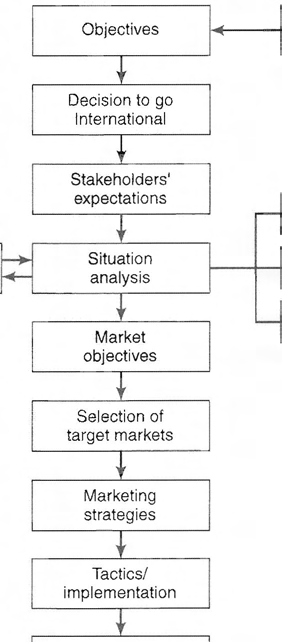CHAPTER 6
MARKETING IN GLOBAL MARKETS
A Jicensing arrangement contains risk, in that if the business is very successful. profit
potentials are limited by the licensing agreement. Alternatively, a licensor makes a long-
term commitment to a firm and that firm may be less capable than expected. Or, the licensee
may be unwilling to invest the necessary resources as needed to be successful. Licersing
may be the least profitable alternative for market entry. Scarce capital, import restrictions,
or government restrictions may make this the only feasible means for selling in another
country.
Franchising represents a very popular type of licensing arrangement for many con-
sumer products finns. Holiday Inn, Hertz Car Rental, and McDonald's have
expanded
into foreign markets through franchising.
Joint Ventures
A joint venture is a partnership between a domestic finn and a foreign firm . Both partners invest money and share ownership and control of partnership. Joint ventures require a greater
commitment from firms than licensing or the various other exporting methods. They have
more risk and less flexibility.
A domestic firm may wish to engage in a joint venture for a variety of reasons; for
example, General Motors and Toyota have agreed to make a subcompact car to be sold through
GM dealers using the idle GM plant in California. Toyota's motivation was to avoid U.S.
import quotas and taxes on
without any U.S.-made parts.
D irect Investment
Multinational organizations may choose to engage in full-scale production and marketing
abroad. Thus, they will invest in wholly owned subsidiaries. An organization using this
approach makes a direct investment in one or more foreign nations. Organizations engag-
ing in licensing or joint ventures do not own manufacturing and marketing facilities abroad.
By establi shing overseas subsidiaries, a multinational organization can compete more
aggressively because it is "in" the marketplace. However, subsidiaries require more investment as the subsidiary is responsible for all marketing activities in a foreign country. While
such ope: ations provide control over marketing activities, considerable risk is involved. The
subsidiary strategy requires complete understanding of business conditions, cllstoms, mar-
kets, labor, and other foreign market factors.
u.s. Commercial Centers
Another method of doing business overseas
come in the form of u.s. Commercial Cen-
ters. 8 A Commercial Center serves the purpose of providing additional resources for the promotion of exports of U.S. goods and services to host countries. The Commercial Center does so by familiarizing U.S. exporters with industries, markets, and customs of host
countries. They are facilitating agencies that assist with the three arrangements just discussed.
U.S. Commercial Centers provide business facilities such as exhibition space, con-
ference rooms , and office space. They provide translation and clerical services. They have
a commercial library. They have commercial law information and trade promotion facili-
ties, including the facilitation of contacts between buyers. sellers, bankers, distributors, agents, ano government officials. They also coordinate trade missions and assist with contracts and
export and import arrangements.




THE INTERNATIONAL MARKETING PLAN
133
MARKETING CAPSULE
•
1. International marketing involves the
in making one
4. There are also several reasons to avoid entering interna-
or more marketing decisions across national boundaries.
tional markets, including too much red tape, trade barri-
2. The debate between standardization versus customization
ers, and transpOitation difficulties .
of the international marketing strategy is unsettled; best
5. The stages of going international are as follows: export-
to consider on a case-by-case basis .
ing, licensing, joint ventures, direct investment, U.s.
3. There are many reasons to enter an international market
mercial centers, trade intermediaries, and alliances .
led by large market size and diversification.
Trade Intermediaries
Small manufacturers who are interested in building their foreign sales are turning to trade
intermediaries to assist them in the sale and distribution of their products. These entrepre-
neurial middlemen typically buy u.S.-produced goods at 15% below a manufacturer's best
discount and then resell the products in overseas markets. These trade intermediaries account
for about 10% of all U.S. exports.9 The trade intermediary provides a valuable service to
small companies, which often do not have the resources or expertise to market their prod-
ucts overseas. The trade intermediaries have developed relationships with foreign countries;
these relationships are time-consuming and expensive to develop.
Alli ances
Heineken, the premium Dutch beer, is consumed by more people in more countries than
any other beer. to It is also the number-one imported beer in America. Miller and Budweiser,
the two largest American beer producers, have entered into global competition with Heineken,
partly because the American beer market has been flat. They are doing so by forming alliances
with global breweries such as Molson, Corona, and Dos Equis. Heineken has responded to
the challenge, heavily promoting products such as Amstel Light and Murphy's Irish Stout.
Heineken has also begun developing an alliance with Asia Pacific Breweries, the maker of
Tiger Beer.
THE INTERNATIONAL M A RKETING PLAN
It should be apparent by now that companies and organizations planning to compete effec-
tively in world markets need a clear and well-focused international marketing plan that is
based on a thorough understanding of the markets in which
company is introducing its
products. The challenge, then, of international marketing is to ensure that any international
strategy has the discipline of thorough research, and an understanding and accurate evalu-
ation of what is required to achieve the competitive advantage. As such, the decision sequence
in international marketing (see Figure 6.1) is much larger than that of domestic markets.
As noted in the next Integrated Marketing box, it is also more complicated.










134

















